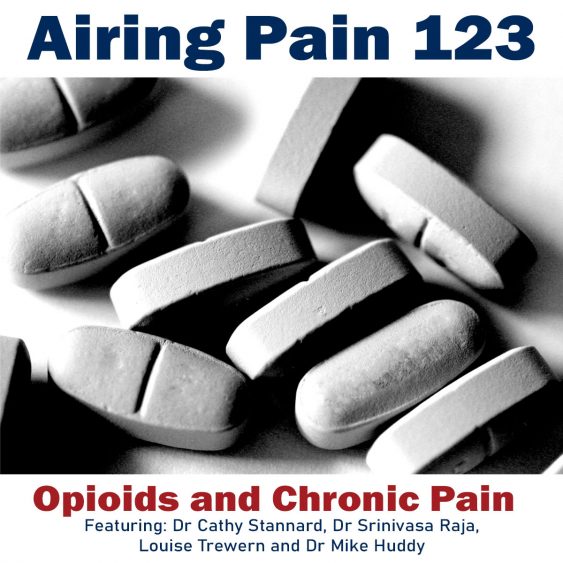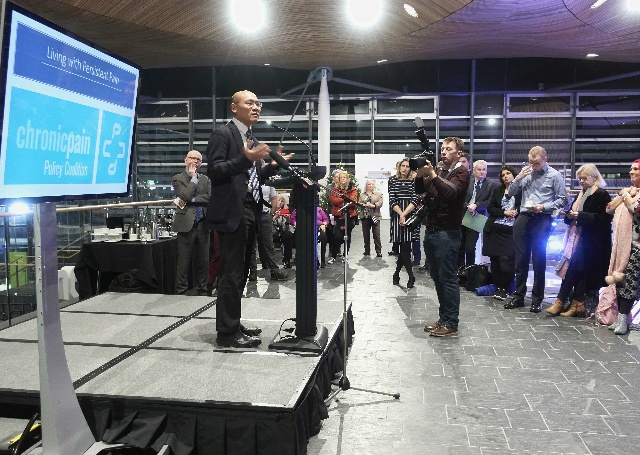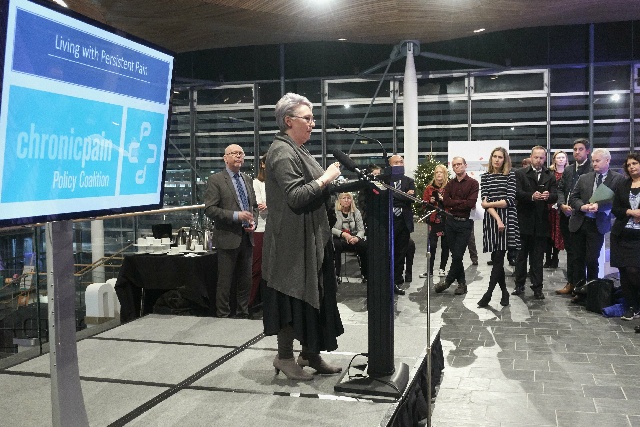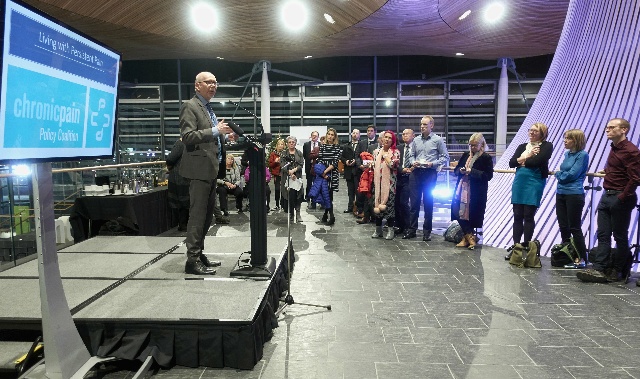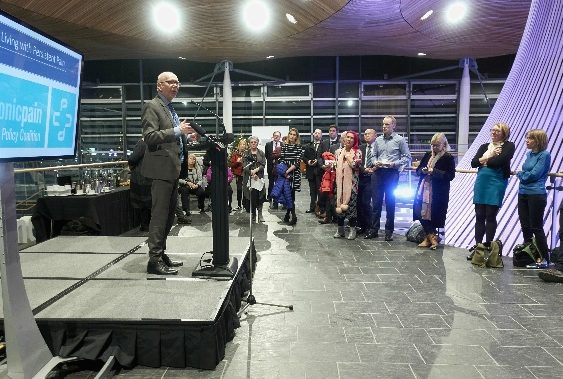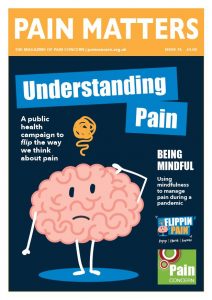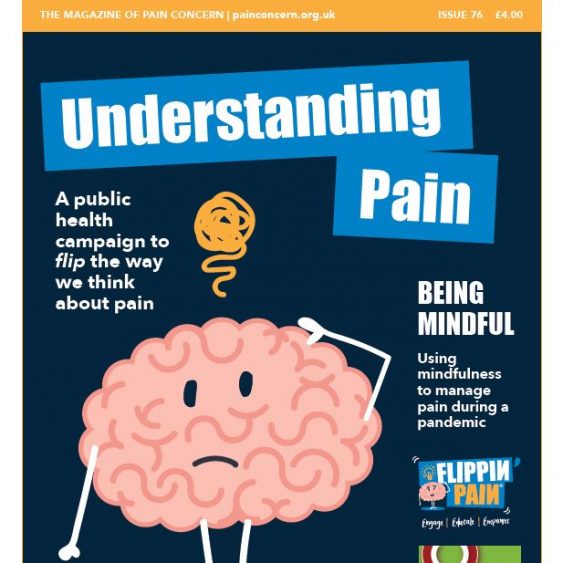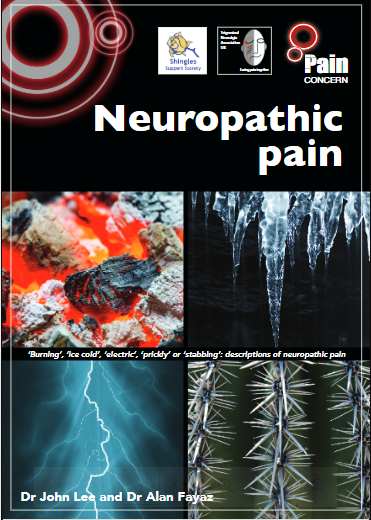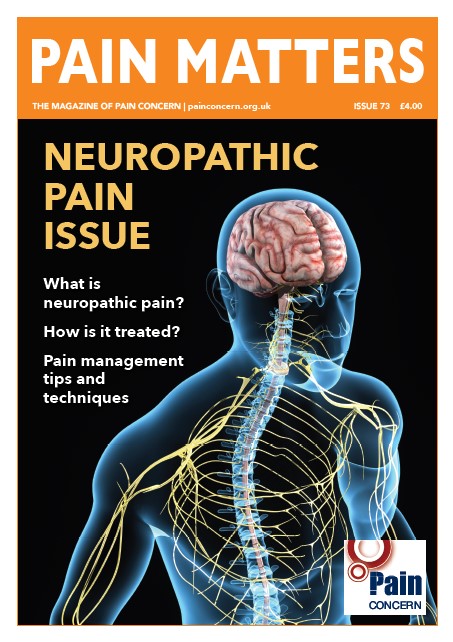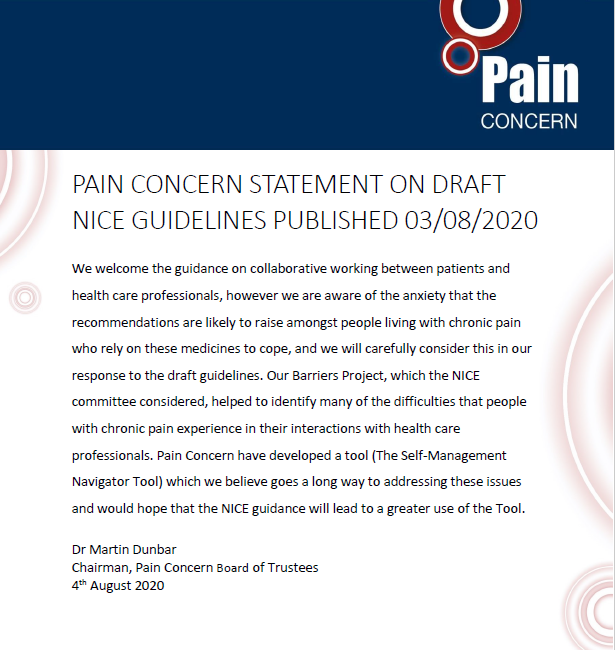Involving patients in researching their own condition – it seems logical, so why is it not more common?
To listen to the programme, please click here.
This edition was facilitated by the British Pain Society and recorded at their Annual Scientific Meeting 2019.
In this edition of Airing Pain, Paul Evans investigates the potential for patients to play an integral role in research, alongside the professionals. Through discussions with patients John and Mark, both of whom are part of research groups, he sheds light on the importance of patients shaping the research and treatment of their own condition. From patients being included in directing their own treatment plan to actually influencing the direction of original scientific research, there are many benefits to their involvement.
Louise Trewern, a member of the BPS Patient Liaison Committee, speaks of her journey from coming off opioids to working with doctors in order to help others in similar situations. She highlights the need to break down the ‘language’ barrier between professionals and patients.
Margaret Whitehead and Julie Ashworth explore how the BPS and the University of Keele, respectively, are encouraging patient involvement. Specifically, Julie talks about the University of Keele’s efforts to improve primary care with their programme PROMPPT.
Finally, Paul discusses the future work required to challenge the ‘doctor knows better’ attitude excluding patients from influencing the treatment of their condition for future generations.
Issues covered in this programme include: Opioids, educating healthcare professionals, fibromyalgia, research, patient voice, patient involvement, peer support, placebo, social media, epidemiology, Twitter and volunteering.
Paul Evans: This is Airing Pain, a programme brought to you by Pain Concern, the UK charity providing information and support for those of us living with pain and for healthcare professionals. I’m Paul Evans.
Margaret Whitehead: It is a paradigm shift in the way that research will develop. And we have to see it as a long journey – ten, twenty, thirty years, before everybody’s adopted – I hope it’s not that long. What we’re trying to raise is what it could be like and how do we plot that path to get there. So there’s a very small number of people at the moment involved in it. But, increasingly, there are people who are skilled at involving patients and mediating, really, between the scientists and the patients. At some point in the future it will be [that] everybody’s talking the same language.
Evans: In the previous edition of Airing Pain [116 – available here], I talked to leading international scientists about their ground-breaking research into neuropathic pain. In this edition I want to turn the tables, so to speak, and move the spotlight on to what patients themselves can contribute, not as subjects or guinea pigs to be studied, but as integral members of the research team. Now it is recognised that involving patients as research partners has a significant impact not only on improving the methodology and research outcomes but gives credibility to the results and, let’s face it, in terms of ethics, patients should have a say in decisions that will impact on their daily lives. So, in this year’s British Pain Society Annual Scientific Meeting, a group of patients spoke to delegates about their role as research partners. It was chaired by former Co-Chair of the British Pain Society’s Patient Liaison Committee, Margaret Whitehead, and I spoke to her, along with fellow patients who had taken part in the session, Louise Trewern, Mark Farmer and John Norton. John first:
John Norton: I have long experience of being a patient representative in north-west London. We founded a group as long ago as six years ago, really to do with working towards integration of Health and Social Care, which we are still working towards and we’ll hopefully get there.
In the course of that I got the opportunity to join Imperial’s, what’s called the Patient Safety Translational Research Centre – [catchy] – yeah, now there’s a name for you. I was very privileged to do that – a wonderful group of about a dozen patients and carers from a variety of different backgrounds, and we worked over two years with, probably by now, about twenty researchers, helping them to organise their research with patients and public in mind and, more than in mind, directly involved in the planning and the carrying out of the research. And I find that a very rewarding, very rewarding activity.
Evans: When I saw the talk about involving patients in research I thought, well there is no research without patients, that’s the whole point of research.
Norton: That’s a fully understandable reaction but it was pointed out today that there are two sides to patients being involved in the research – those who are suitable to be participants in the research, as what I would loosely call ‘guinea pigs’ [with] research being carried out on them. But the growing thing, and the thing that is now mostly required to obtain grants for research, is that patients should be involved in a sense at the other end – in the planning and the organisation – to help the researcher carry out their research in a patient-centred and patient-sensitive way. And I think that distinction, I’m sure, is still going to confuse matters for some time yet, that your reaction to it is a very natural one. We probably, mostly sensibly, have to point that out, that there is that distinction. I mean, I have been, when I had an incipient cataract many years ago, I was in a research project for a drug by a rather well-known drug company. I’m pretty certain I was taking the placebo because it did nothing for my cataract but a surgeon did happily after that [laughter]. But I delayed having the operation for about five years to be in the research. But now I’m the other end of things and, happily, I’m well, even though way, way beyond my allotted span in this life and trying to put what I have left to use for the benefit of the next generation or the one after which is what research is really about.
Evans: Sitting next to John is Mark.
Mark Farmer: Yes, I’m Mark. I suffer from fibromyalgia, arthritis and hemiplegic migraines, which have been very disabling. I’m more of a fan of medication than some people are because I think it has helped me a lot, actually, to be able to live a sum of a life – I’d put it that way. I also sit on a number of local NHS bodies like Healthwatch, I’m a member of, and the reason I am mentioning that is because we are the statutory body for patient representation in every local area and that’s our legal power that we have. And we get lots of reports about how patients are not really properly involved with research. But, most worryingly, with that kind of treatment plan, there’s still too much of ‘the doctor knows better than the patient’ rather than it being a, you know, fifty-fifty partnership: ‘here’s a toolkit that you could use as a patient’. And I think that’s what concerns me on a national level, is that we need to push that message out a bit more about what concerns people have around pain at a local level.
Louise Trewern: I’m Louise Trewern and I’m part of the Patient Liaison Committee – new member really. I became involved through my story with opioids because two years ago I was the first in-patient to come off opioids at Newton Abbot Hospital and, since then, it’s completely altered my life – drastically.
Evans: How do you mean it changed your life when you came off opioids?
Trewern: Drastically – and the day before I went in to hospital to come off I had clocked up something like twenty-five steps on my pedometer, probably that was from the bed to my chair, the chair to the bathroom and then back to bed. And I was touching twenty-five stone in weight and my life was pretty non-existent by this point. I’d been on opioids for over twelve years – high dose.
It was suggested over a period of time that I needed to come off this medication because, in actual fact, it wasn’t helping me – which took a long time for the message to get through. And then I suffered a couple of quite severe medical episodes which meant I was an emergency admission to hospital – which met the criteria to have me in and get me off these opioids. Since then, we’re talking two years now, I’ve lost seven stone in weight, I now walk up to five miles a day, still live with pain on a daily basis, but I deal with it without medication, apart from perhaps a couple of paracetamol. And so I’m trying to get the message out there that there are other ways, not for everybody, but there are other ways of coping with your pain other than just taking painkillers.
Evans: Louise – are you involved in research?
Trewern: I am working with the doctors that helped me come off the opioids. About twelve months after that, because I needed that long to recover as it were. I’ve been working with a multidisciplinary group on a committee called the Rational Use of Opioids. I’m helping the team make patient leaflets and videos for the website, this is in Torbay, for proper use of opioids, which will hopefully help those that don’t seek help – and those that do – in-patient and out-patient leaflets. So they’re in Torbay and we are lucky because I don’t think it’s across the country yet. But Torbay really are engaging, or trying to engage, with patients. They are taking my experience, plus putting it together with the medical side and physiotherapy – all the different areas are coming together to make these leaflets that will be circulated in GP surgeries and on the website. And so, yeah, it is working. And I’m sure, with Torbay, it’s not just in this with opioids it’s with other things as well. And so, yeah, it’s hopeful that that will continue and it needs to be countrywide I think.
Evans: So, when you ceased opioid use, how was it put to you that you should stop?
Trewern: It was gradually, over a period of months, suggested to me that the dose I was on was not helping me – it was making me worse. And that a lot of the symptoms I was suffering [were] as a result of my opioid use. And definitely hyperalgesia was one of my biggest problems. I couldn’t have dental treatment properly. I had to have multiple injections because they couldn’t numb me. I couldn’t have the cats walk over my legs because the pain was intense. And all this gradually ceased after I came off the opioids.
Evans: How was that experience used to help others?
Trewern: My initial week in hospital was where I came, they halved my dose overnight, and the doctor said to me that ‘in the morning your pain will not be any worse, I can guarantee that’ and I had to put my trust in him and it was true. It wasn’t worse. The things I experienced, both before and after, are not all in the journals. It’s not all written down. Some things they’ve heard about but they didn’t know for sure that it was happening. And it’s not just me, there’s several patients now in Torbay that they’ve helped since and it’s just that I was the first in-patient that they did this with. So, whereby certain things they thought would happen they’re now going to put this in a warning in the leaflet. You know, ‘if you come off opioids too quickly this could happen’. And ‘we’ve been told this happens and not necessarily to everybody but it can happen’. Just so that people are aware of the dangers – you can’t just stop these drugs – but not everybody knows this.
Evans: So – rather than like the leaflets that we get in all our packs of medicines and tablets that list all the … everything that could happen to you and more, at least it’s coming from your voice ‘this has happened to me and this is what can happen after’.
Trewern: Yes that’s it. And one of the key things that we’ve gone out of our way to make sure of is that, between the team, the language is what can be understood by the person taking those opioids.
Norton: That’s great. Your group has been a research project in itself, but it’s going to benefit other people. I mean, what can be better? Patient-led, patient-experienced, patient-communicated. Fantastic. [Laughter]
Evans: Margaret, what can the British Pain Society do to encourage this? How could patients get involved in research projects themselves?
Whitehead: Well, the British Pain Society is looking at facilitating a ‘network’, I suppose, of patients who might become involved in pain research. Obviously, we don’t want to trip over other things that are happening because there will be research units like Imperial and at University College and all over the country who will also be doing this – growing this network of patients who offer support and are available. It is a priority for them. It’s really how to take it forward and this is what the Patient Liaison Committee will be prioritising, we hope, in the next couple of years. It will take time. What the British Pain Society is looking for is patients who are interested in the work of the British Pain Society to sign up to the reference group and get involved in the Patient Liaison Committee. And then, in due course, there will be a research network – a panel of patients, with particular types of pain – who will either get involved themselves or will use their networks of other patients to help get them involved in research. But this is happening all over the country in all sorts of organisations.
Evans: That’s Margaret Whitehead, former Co-Chair of the British Pain Society’s Patient Liaison Committee.
Well, one organisation that’s currently, current that is in the Autumn of 2019, looking for people to take part in an important research study is the University of Keele. They’re looking to recruit people who live with long-term pain or care for someone who does. People who have experience of using medicines for long-term pain now or in the past and who’d like to share their experience and views to take part in a study to help understand how clinical pharmacists working in GP surgeries can help improve care for patients with long-term pain. Julie Ashworth is a senior lecturer at the University of Keele and an honorary consultant in the Community Pain Service with the Midlands Partnership Foundation Trust. And the study goes under the heading PROMPPT.
Julie Ashworth: PROMPPT is an acronym that has a very long title behind it. So it is ‘Proactive Review of Patients taking Long-term Opioid Medicines for Persistent Pain led by Clinical Pharmacists in Primary Care Teams’. And out of all that we’ve picked a few capitals to give us a nice catchy…
Evans: Honestly there’s no need that’s very, very clear [laughter].
Ashworth: Our aim is to try and improve care for people with long-term pain, persistent pain, chronic pain – all the different names that are given to it because we know that most of these patients are managed in primary care. Most drugs are prescribed in primary care. Even if that’s not where they were started that’s where they continued. And we know that a lot of people continue on drugs that aren’t really helping them, but may be causing them harm, because they don’t know what else to do. Often they’re not reviewed as, perhaps, the guidelines say they should be because the opportunity doesn’t arise or there isn’t time in a routine consultation – often people with long-term pain have lots of other problems. It’s sometimes difficult to discuss all of the pain medicines in a routine appointment. So our idea is that we don’t need more guidelines. We kind of know what we should be doing. We need to do it.
And so to do it we need somebody who’s got the time, the skills, the expertise to do that and we need to know what we should be doing as well. So what would people who are struggling living with long-term pain, who take lots of drugs that maybe aren’t helping very much, what would they want from their GP practice in terms of review? What would they want that to be like, I guess. We need to find that out first of all. So the research I’m involved in is a five-year programme. And the first year is all about finding that out. So we have interviews with patients, we have interviews with clinical pharmacists as well. And we have interviews with GPs because we need to know what clinical pharmacists think they might need in terms of training to make them be able to do this. Alongside that we’re going to have a slightly novel way of doing research with an online research blog. And that’s going to be called the Q PROMPPT Blog. And, basically, that’s going to be an online discussion forum which we set up just for the research – just for twelve weeks. And, in a way, it will be like having twelve focus groups but with an online group of people. And the reason for doing that is it allows us to get the views of a much wider range of people including the sort of people that don’t often volunteer to take part in individual interviews or maybe they can’t, maybe they have other responsibilities that they have to take care of. So it hopefully will allow us to just check that the sorts of things we hear from patients who will come and talk to us on a one to one basis are the main issues for other people.
Evans: Just explain to me what you mean by a blog?
Ashworth: I’m also learning a lot from my younger and more technically-minded colleagues. Essentially, it’s like a discussion forum, like Facebook, where you can post a comment and then someone can reply. And the idea would be that to get a conversation going we will have an area of the research that we’re interested in finding more about. We will put out a short video presentation, setting the scene if you like, and asking a question or two to get the conversation started and then we’ll ask people to share their views, their experiences, tell us what they think. There will be researchers supervising the whole process. So moderating, if you like, but also chipping in, if needs be, to keep the conversation going, or following up with a question if someone says something really interesting. We’ll try and keep each discussion focused around one area but then move on to another area. Some of the areas we know for sure the sorts of things we’re going to be discussing now, but some of them may arise out of the discussions. So if the people in the blog say things that we find are really interesting, that we hadn’t thought perhaps were so important, then we can create a whole topic about that to follow up on it. So we’ll leave that flexibility for the end.
Evans: One thing that occurs to me, and I might have given the game away by saying ‘what is a blog’, is that a certain generation who have chronic pain do not use social media.
Ashworth: We explored this with our research users’ group – many of whom are from that very generation. It was true – they found that they weren’t particularly social media-minded or were a little bit wary. But what they found was if they were led to it from a trusted source, so that might be something like the Pain Concern website, it might be the University’s research page – then they were comfortable with it if it came from, say, the NHS in some way. So they were okay with that. And we work with them on our plans for the advertising campaign for recruitment, so that’s one area. But we know there will be some people that don’t want to take part in online research but we are having individual interviews as well. And we will be looking at other work that’s been done by other people. We will pull it all together and then take the whole picture. So the online research is about confirming findings in a much wider population – it’s not a standalone thing.
Evans: So it’s setting the agenda in many ways?
Ashworth: Yes, yeah. And it will help us. What we’ll do is take the information to a stakeholder group, which is comprising lots of different healthcare professionals who have some relevant experience, but also patients with relevant experience of pain. We’ll take those findings along with the literature and the guidelines. And it will give us this picture that allows us to decide how we should structure clinical pharmacists reviewing these patients, what sort of training would need to happen. And then there are other stages to the development, so we’ll test it out with some willing clinical pharmacists that we will recruit – a small number in three different GP practices – and some real patients to do observed reviews and learn from that and then improve things with each stage of testing. And we’ll also do some focus groups with clinical pharmacists just to find out a little bit more about the training needs.
Evans: So it’s a five year project – Q PROMPPT?
Ashworth: Q PROMPPT is four studies – one of which is the Blog. It includes the interviews, individual interviews, the blog, the in-practice testing –with the small number of pharmacists and patients and the clinical pharmacists’ focus groups – and we’ve put these four things together and call them the Q PROMPPT study.
Evans: Will they get to meet each other face to face at some point?
Ashworth: The patients on the blog? No, it’s all anonymous. And we’ve done that because [of] the feedback we got from our research users’ group, that was something that would make them feel more comfortable about joining in, but also because we don’t want to keep people’s personal data with this blog. So they will sign up with an email address, but they won’t have to give their real name, and their email address will just stay with the website administrator. And at the end of the twelve weeks all of that data will be deleted and it won’t exist anymore. And all we will get is an anonymised transcript. There is a personal messaging system where they can contact the website administrator but it’s not like Facebook where you can get to know new friends.
Evans: What are you looking for at the moment?
Ashworth: What we would like to have is that people are aware that we are looking at this area of research and that we are really interested in the views of people with pain. And if they were to follow us on Twitter, if they do that sort of thing, or look at our website, www.promppt.co.uk, that’s PROMPPT with three Ps – so P-R-O-M-P-P-T. The Twitter is @keelepain. If they follow us on there then they’ll find out, from the horse’s mouth as it were, when we’re ready to go live with this blog and they can be in right from the start. But even if they don’t pick it up right at the start they will be able to go back and join in all the initial discussions later. So really we want people to understand what we’re doing and then they’ll be able to follow the progress of our research through the website for the five years and to the point where we get our results.
Evans: That’s Julie Ashworth of the University of Keele. And that website again is promppt.co.uk. And PROMPPT, as Julie says, has three Ps and is spelled P-R-O-M-P-P-T – promppt.co.uk. And the Twitter address is @keelepain and Keele is spelled K-E-E-L-E.
John Norton, of the British Pain Society Patients as Research Partners Group:
Norton: The other thing which is growing is patients initiating what the research should be. I’m certainly involved with one new project which is in the digital world, which is founded on that idea that patients actually are going to be involved in co-creating, or whatever you’d like to call it, the actual subjects that are going to be researched and I think that’s a development. Margaret, would you agree that’s a development that I think we’re hopefully going to see more of?
Whitehead: Absolutely. So the ideas don’t just come from professionals, they will still come from professionals as well, but from patients, and in every area of pain there needs to be more research and that’s where the patients’ organisations themselves have a massive role. It’s the patients’ organisations who already have that network of those people living with that particular type of pain. They are a group of people who could really accelerate this change by talking to their members – ‘where do you think the research needs to be?’. I think there’s an open door as long as there’s some money behind all this because money is required to involve patients properly in research and for it not just be ‘come along to a meeting.’ and then because people come along to a meeting they feel that box is ticked – it has to be involvement at every stage – a lot of it will be.
Another point is about language: ‘I’ve been involved in an application for a grant’ is professional speak. They’re talking a completely different language. And a patient goes in and really is disempowered by feeling really quite stupid. Even though the professional knows that that’s not the case but you feel, ‘I can’t say what I want to say because I really don’t understand what they’re talking about and I’ll just sound silly, and it’s probably best if I keep quiet’ and that’s the role of patient researchers a lot. I don’t know if you’ve found that John, is going at the very beginning saying, ‘well that doesn’t really make sense’. And if you give that to a patient they’ll just say ‘Oh okay, because you’re the professional, it must be okay’. But, in fact, they do want to know a lot more. And it’s just the way that the information is communicated so having patients at the very beginning, going through everything, going through the lay summary – but not just that – going through everything that’s involved in the research, and also advising them on the amount of time that patients may want. So just because a researcher will understand their area completely, they may well be the world expert in this particular field, and think that they can send something to a patient and expect them to turn it around within a week. So that’s where the patient thing can come in.
Norton: I think there’s no doubt that if patients and professionals are going to work successfully together that they have to speak a language that both can understand and scientific terms – you know – it’s only recently, very strange, amazing, I’m sure you probably all saw this, it is only within the last six months or so that doctors were told by the GMC or the BMAF, or whatever, that they had to write to their patients in language that the patients would understand. It’s just … just … that’s almost amazing isn’t it really [laughter].
Evans: This seems like a good time to remind you of our small print that whilst we in Pain Concern believe the information and opinions on Airing Pain are accurate and sound, based on the best judgements available, you should always consult your health professional on any matter relating to your health and well-being. He or she is the only person who knows you and your circumstances and, therefore, the appropriate action to take on your behalf. So, to end this edition of Airing Pain on ‘Patients as Research Partners’ – does it have a future, other stumbling blocks and what is needed to provide a good future for it?
Margaret Whitehead and John Norton. Margaret first:
Whitehead: It’s the beginning of a long journey. It’s very difficult for everybody to conceptualise it, it is a paradigm shift in the way that research will develop. And we have to see it as a long journey – ten, twenty, thirty years – before everybody’s adopted. I hope it’s not that long. But it could be because that’s how long these shifts in the way of thinking take to really embed themselves.
So it’s absolutely true that there’s a lot of, let’s say it’s tokenism, because involving patients, the people who do it really think they’re involving patients but they don’t necessarily know how to do it. And because they’re so busy, and there’s so many other pressures on their time, it’s not been done as well as it could be. So not the right language, not the right support, etc. What we’re trying to raise is what it could be like and how do we plot that path to get there?
There’s a very small number of people at the moment involved in it but, increasingly, there are people who are skilled at involving patients and mediating, really, between the scientists and the patients. And it shouldn’t really need mediation but, at some point in the future, it will be everybody’s talking the same language.
Evans: How important is it that you know how you’ve contributed to that research project?
Norton: To me, greatly important. I don’t like wasting my time. And I like to feel that I’m doing somebody else some good but, in saying that, for any of this patient participation, lay partnership and getting involved in whatever project in the medical world, it is equally important that it’s doing good for you yourself. There’s no harm, indeed I think there’s every merit, in having a modicum of selfish motive in getting involved in volunteering work that helps one feel satisfied. It’s very important to feel satisfied about what you’re doing but what you’re referring to, about knowing about the outcomes, is an important part of that satisfaction as well. I think my colleagues would agree. It gets you out of bed in the morning doesn’t it?
Evans: I always think of it, as a research project comes up – well in twenty years’ time this will be fine, but I won’t be here in twenty years’ time, I don’t think, but you have to think of it in another way as well – twenty years ago the research was being done that is making me feel a little bit better now. [General agreement]
Norton: I think of my first great granddaughter who was born in April. I think of her generation. That’s where the benefit is. It doesn’t worry me, and I think most of the people who get involved in this, by and large, are not worried that it’s not for them that they’re doing this. It will help them in various ways of course but, essentially, the research is not for their benefit. It’s for those down the line and I think we get satisfaction from feeling that we’re pushing something that is going to help in the future.
Contributors:
- John Norton, patient
- Mark Farmer, patient
- Louise Trewern, member of the BPS Patient Liaison Committee
- Margaret Whitehead, past co-chair of the BPS Patient Liaison Committee
- Julie Ashworth, Senior Lecturer University of Keele and Honorary Consultant at the Community Pain Service with Midlands Partnership Foundation Trust.
More information:





